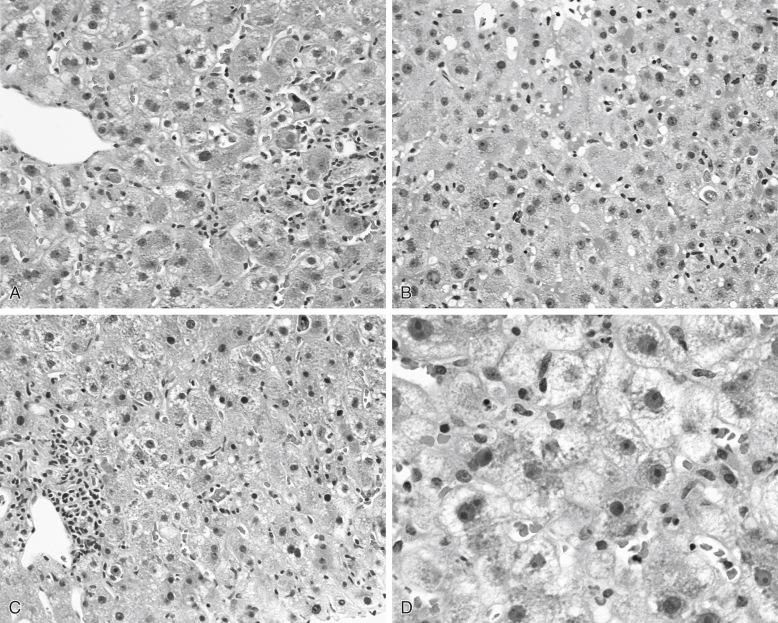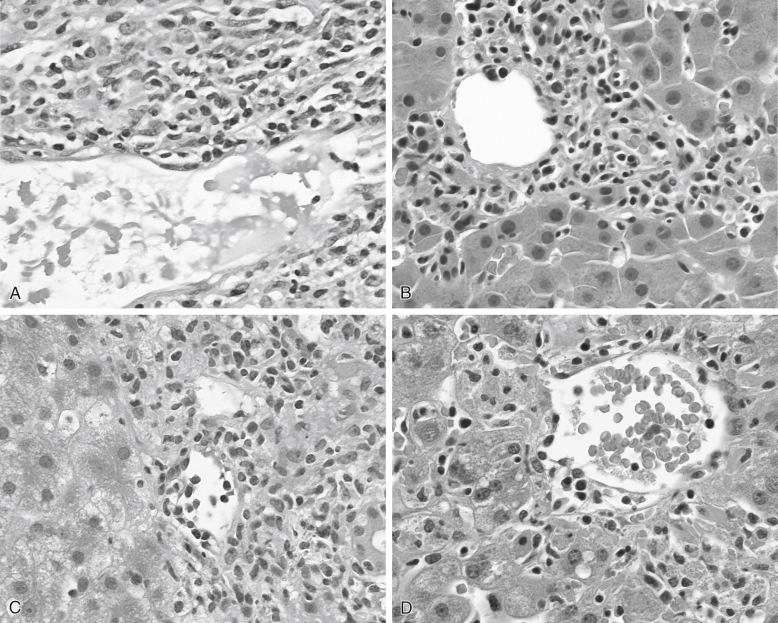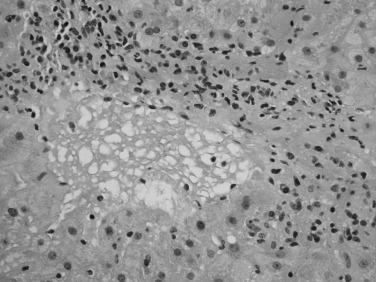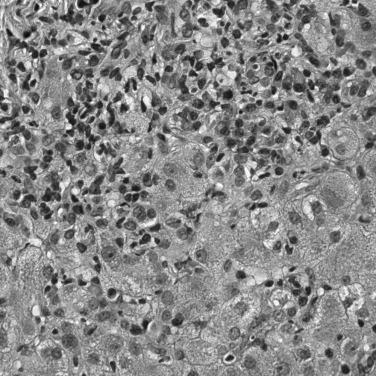Physical Address
304 North Cardinal St.
Dorchester Center, MA 02124
Liver transplantation has enjoyed tremendous success, in part because of the unique immunological properties of the liver and in part because of the development of new pharmaceutical agents to treat rejection and infection. Fortunately, liver allografts are infrequently lost to rejection or opportunistic infection. Recurrent disease, however, remains a serious problem and is a frequent cause of graft dysfunction and loss.
Hepatitis C, unfortunately, recurs in nearly all allografts. The severity of recurrence and the progression of fibrosis to cirrhosis are variable, and neither can be reliably predicted without biopsy. Reinfection of allografts occurs at reperfusion. In most patients, viral RNA can be detected in peripheral blood by polymerase chain reaction (PCR) as early as a few days after transplantation. Histological recurrence is usually evident in biopsy specimens at 2 to 3 months but can be seen as early as 1 week after transplantation. Progression of hepatitis C to cirrhosis is more rapid in the transplant setting, particularly in patients who have been treated for multiple episodes of acute rejection (AR). Therefore the primary reason to perform a liver biopsy has been to distinguish recurrent disease from AR and thereby avoid unnecessary immunosuppression. Furthermore, as increasingly successful treatment of hepatitis C has been implemented, biopsies are also performed to confirm histological injury from hepatitis C before beginning antiviral treatment, as well as to assess the efficacy of treatment later on. In cases of recurrent hepatitis C, histological features seen in biopsy specimens during the first year of transplantation may also be predictive of more aggressive disease. The presence and severity of macrovesicular steatosis, the severity of necroinflammatory activity at presentation, the extent of hepatocellular apoptosis, the presence of ballooning degeneration and cholestasis, and the extent of hepatic stellate cell activation have been reported to be associated with more severe disease recurrence.
Although the diagnosis of recurrent hepatitis C and AR in the early posttransplant period maybe straightforward, such distinction becomes more difficult with the transition to late acute rejection (LAR) and chronic hepatitis. Indeed, because most patients have histological evidence of recurrent disease very shortly after transplantation, the differential diagnosis is generally not simply hepatitis C versus rejection, but instead is hepatitis C versus hepatitis C and AR.
The histological features of hepatitis C in a transplant liver are much like those in a native liver with a few exceptions. Early in the course of recurrence the initial histological picture resembles that of acute hepatitis with a predominance of lobular activity. Later there is a transition to predominantly portal infiltrates and interface hepatitis typical of chronic hepatitis C.
In most patients, scattered apoptotic hepatocytes are the first histological sign of recurrent hepatitis C, but this finding can also be seen in non–hepatitis C-infected grafts, particularly in the first few weeks after transplantation. Steatosis has also been reported as one of the earliest histological feature of recurrent hepatitis C, but this finding is neither specific nor sensitive. Lobular activity ( Fig. 85-1 ) in most patients consists of small clusters of lymphocytes, apoptotic hepatocytes, patchy hepatocyte swelling, or any combination of these findings. Aggregates of hypertrophic Kupffer cells are often present. Alternatively, there may be an extensive sinusoidal lymphocytic infiltrate with only rare apoptotic hepatocytes. With time, most biopsy specimens in patients with recurrent hepatitis C demonstrate portal lymphoid aggregates with varying degrees of interface activity. These aggregates are characterized by extension of lymphocytes across the limiting plate in association with apoptotic or degenerative-appearing hepatocytes ( Fig. 85-2 ). Most specimens demonstrate minimal or mild activity; however, moderate to marked activity may also be present and in fact is more commonly seen in allografts than in native livers of nonimmunocompromised patients. Bile duct infiltration by lymphocytes is frequently seen but is generally mild and without significant epithelial injury. Ductular reaction at the interface often results from interface activity and may complicate the assessment of biliary obstruction in these patients (see later).


There is extensive overlap between the features of recurrent hepatitis C and AR, particularly LAR ( Table 85-1 ). The diagnosis of typical AR is based on three findings (see Chapter 84 ): (1) mixed portal inflammatory infiltrates; (2) infiltration of bile ducts by lymphocytes, with epithelial cell injury in the form of pyknosis and vacuolization; and most important; (3) portal and central vein endotheliitis and, in severe cases, arteriolar endotheliitis.
| Acute Rejection | Hepatitis C | Primary Biliary Cirrhosis | Primary Sclerosing Cholangitis | |
|---|---|---|---|---|
| Portal infiltrate | Mixed, with lymphocytes, neutrophils, and eosinophils. Diffuse, not nodular | Predominantly lymphocytic, often nodular | Lymphoplasmacytic, sparse or dense, may be nodular, may be centered on bile duct. Edema and neutrophils in some cases | Predominantly lymphocytic or lymphoplasmacytic. Edema and neutrophils in some cases |
| Bile ducts | Variable infiltration by lymphocytes from mild to marked, with epithelial injury from mild to severe | ± Mild infiltration by lymphocytes with mild epithelial injury | Variable infiltration and injury from mild to florid duct lesion | Variable from normal to lymphocytic infiltrate to periductal edema and fibrosis |
| Portal veins | Swollen or pyknotic endothelium, detached from basement membrane by subendothelial inflammatory cells (endotheliitis) | Lymphocytes may encroach upon endothelium from the stroma or adhere to the luminal aspect of the cell | Lymphocytes may encroach upon endothelium from the stroma or adhere to the luminal aspect of the cell | Lymphocytes may encroach endothelium from the stroma or adhere to the luminal aspect of the cell |
| Interface activity | Often seen in moderate to severe acute rejection and in late acute rejection | Minimal in early recurrence, variable from mild to marked with chronicity | Ductal metaplasia and interface activity is often present | Ductal metaplasia and interface activity is often present |
| Lobules | Inflammation and cellular injury in severe acute rejection and in late acute rejection | Predominant in early recurrence, variable later | ± Activity, variable | ± Activity, variable |
| Central vein | ± Endotheliitis and perivenular inflammation and necrosis (central perivenulitis) in severe acute rejection or late acute rejection | ± Focal and mild perivenulitis (present in less than half of the lobules) | Generally uninvolved; however, focal/mild perivenular activity may be seen in cases with a prominent component of hepatitis | Generally uninvolved; however, focal/mild perivenular activity may be seen in cases with a prominent component of hepatitis |
In recent years it has become apparent that AR in patients more than several months from transplantation shows slightly different histological features than typical AR and is less likely to demonstrate eosinophils, bile duct infiltration, and endotheliitis. Instead, biopsy specimens from patients with LAR may resemble chronic hepatitis with fewer blastic lymphocytes, less conspicuous endotheliitis, and more lobular activity. Therefore to distinguish between LAR and recurrent hepatitis C virus (HCV), one cannot rely on the finding of eosinophils and endotheliitis. Central perivenulitis is one feature that can be helpful in making such a distinction (see later).
In hepatitis C the infiltrates are predominantly lymphocytic. In AR the infiltrates are mixed and composed of lymphocytes, blastic lymphocytes, eosinophils, and neutrophils. Furthermore, in AR the infiltrates are diffuse, not nodular as is typical of hepatitis C. Eosinophils are occasionally seen in native liver biopsy specimens from patients with hepatitis C but are only rarely prominent, so their presence is helpful in establishing a diagnosis of AR. Likewise, the presence of neutrophils favors a diagnosis of AR; however, because they frequently accompany the ductular reaction of chronic interface hepatitis and are usually present in bile duct obstruction (BDO) and cholangitis, they are not as helpful as eosinophils in distinguishing between recurrent hepatitis C and AR.
Bile duct infiltration in AR is quite variable and ranges from mild to extensive. Bile duct infiltration may also be seen in hepatitis C; however, it is generally mild and not accompanied by significant epithelial injury, pyknosis, or vacuolization. Therefore when bile duct infiltration by lymphocytes is mild, it is not helpful in distinguishing AR from hepatitis C. When it is moderate to marked and accompanied by significant epithelial cell injury, it favors AR.
Endotheliitis is the most helpful feature in differentiating hepatitis C from AR. However, if endotheliitis is defined too loosely, it can be found in a wide variety of conditions and cannot be used as effectively to differentiate AR from other processes. In hepatitis C, as well as other inflammatory conditions, portal lymphocytes abut portal vein endothelial cells and may be adherent to the luminal surface of endothelial cells. True endotheliitis, in contrast, is characterized by swollen, damaged-appearing endothelial cells separated from the underlying basement membrane by subendothelial lymphocytes and is virtually never present in native liver biopsy specimens with hepatitis C. When the endothelium is seemingly “lifted off” the basement membrane by lymphocytes, one can be relatively certain that one is dealing with AR ( Fig. 85-3 ).

Because lymphoid infiltrates in patients with hepatitis C may obscure portal structures and thus render their examination difficult, the finding of central vein endotheliitis can be helpful in establishing a diagnosis of AR. Central vein endotheliitis is generally seen in cases of moderate to severe AR and may be accompanied by perivenular hepatocellular necrosis or dropout; however, hepatitis C occasionally results in a similar finding. Again, identification of convincing endothelial injury along with subendothelial lymphocytes is very helpful in establishing a diagnosis of AR (see Fig. 85-3 , D ).
Subendothelial lymphocytic inflammation in the arterioles of small- and medium-sized portal areas is rarely seen in AR. In our experience it occurs only in the setting of severe AR with extensive and obvious venous endotheliitis.
Perivenular mononuclear inflammation and hepatocyte dropout are features that can be seen in patients with LAR and in hepatitis C, but they are more commonly seen in LAR ( Fig. 85-4 ). In addition, when it occurs in the setting of hepatitis C alone, central perivenulitis is generally mild and involves only a minority of perivenular regions. Therefore when perivenulitis involves more than 50% of lobules in a biopsy, a diagnosis of LAR is favored, even in the absence of eosinophils, endotheliitis, and bile duct infiltration and injury.

Although interface and lobular activity is generally interpreted as histological evidence of recurrent hepatitis C, it may be seen in cases of moderate to severe AR. In addition, as described earlier, LAR generally manifests as chronic hepatitis. Therefore when interface and lobular activity is present in a late graft, evaluation of central perivenulitis is a helpful feature in distinguishing recurrent hepatitis C alone from recurrent hepatitis C accompanied by LAR.
A recently described posttransplant histological pattern of injury, especially in patients transplanted for HCV, is plasma cell–rich portal and lobular inflammatory infiltrates, hence the term plasma cell hepatitis ( Fig. 85-5 ). Many of these cases are associated with centrilobular inflammation and necroinflammatory activity (i.e., central perivenulitis—see earlier). This pattern of injury closely resembles autoimmune hepatitis in native livers. Although some of these cases are associated with corresponding autoimmune serological markers and suggest an “autoimmune” variant of HCV or an actual autoimmune hepatitis, many appear to be associated with suboptimal or a recent change in immunosuppression, suggesting that this likely represents LAR. Many of these cases have occurred in the setting of antiviral therapy (pegylated interferon and ribavirin), suggesting that this might be an alloimmune response that is triggered by interferon-induced stimulation of the host immune system. The same pattern of injury has, however, been reported in patients with recurrent HCV and no history of antiviral therapy or also in non-HCV patients. In the setting of HCV, cases with plasma cell hepatitis are shown to have a worse outcome than those with typical recurrent HCV.

Finally, we find a few exercises helpful in distinguishing between hepatitis C and AR. While examining biopsy samples from patients who received transplants for reasons other than hepatitis C (particularly allograft biopsy specimens from patients transplanted for acetaminophen toxicity or other noninflammatory conditions), one may obtain a sense of how much steatosis, apoptosis, lobular inflammation, or interface activity can be present and unrelated to hepatitis C. Likewise, examination of native liver biopsy specimens from patients with hepatitis C for features normally associated with AR may be helpful. One may obtain a sense of how often hepatitis C is accompanied by eosinophils, lymphocytic infiltration of bile ducts, perivenular confluent necrosis, and lesions suggestive of endotheliitis (see Figs. 85-2 and 85-3 ).
Often interpretation becomes an exercise in weighing various findings. If there is clear-cut hepatocellular apoptosis and interface activity but only a few eosinophils, mild bile duct infiltration, no or only focal central perivenulitis, and questionable endotheliitis, a diagnosis of AR is not warranted. However, if there is an extensive eosinophilic infiltrate, bile duct infiltrates, convincing endotheliitis, or conspicuous central perivenulitis in more than half of the lobules (or any combination of these findings), a diagnosis of AR should be considered even if rounded lymphoid aggregates and extensive interface activity are present.
Because increased immunosuppression is detrimental to transplant patients with hepatitis C, it is our practice to “raise the bar” for a diagnosis of AR when features of hepatitis C are present. We are willing to err on the side of undercalling AR rather than overdiagnosing AR in these patients.
It is our practice to report the findings as follows:
AR— typical features of AR are present as described earlier.
Recurrent hepatitis consistent with hepatitis C with activity, no AR —typical features of hepatitis C are present with or without mild bile duct infiltration by lymphocytes, no or few eosinophils, no convincing portal or central endotheliitis, and no or only focal central perivenulitis.
Recurrent hepatitis consistent with hepatitis C with activity, cannot rule out mild AR (indeterminate for AR) —typical features of hepatitis C are present along with more marked lymphocytic infiltration of bile ducts or moderate eosinophilic infiltrates (or both), focal perivenulitis, but no convincing portal or central endotheliitis.
Recurrent hepatitis C and AR —lymphoid nodules or interface and lobular activity (or both) are present, with or without bile duct infiltration by lymphocytes, with or without eosinophils, and with convincing portal or central vein endotheliitis or central perivenulitis in more than half of lobules.
Become a Clinical Tree membership for Full access and enjoy Unlimited articles
If you are a member. Log in here